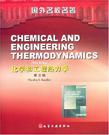化学和工程热力学
出版时间:2002-8 出版社:化学工业出版社 作者:桑德美 页数:772
前言
This book is intended to be the text for a course in thermodynamics for undergrad-uate students in chemical engineering. It has been used in this manner at the University of Delaware for more than twenty years, originally as a course for third-yearstudents and currently for sophomores. I had two objectives in writing the first edi-tion of this book, which have been retained in the succeeding editions. The first wasto develop a modern applied thermodynamics text especially for chemical engineering students, that was relevant to other parts of the curriculum, specifically coursesin separations processes, chemical reactor analysis, and process design. The otherobjective was to organize and present material in sufficient detail, and in such a waythat the student obtained a good understanding of the principles of thermodynamics, and a proficiency in applying these principles to the solution of a large variety ofenergy flow and equilibrium problems.Since the first two editions largely met these goals, and the principles of thermo-dynamics have not changed in the last decade, this edition is similar in structure tothe earlier ones. However, there have been three important changes in engineeringeducation in the recent decades. The first is the availability of powerful desktop com-puters. The second is greater concerns about safety and the environment. The thirdis the application of chemical engineering principles to new technology areas suchas biotechnology, polymers, solidstate processing, etc. In the current edition of thistext I have made changes to address each of these issues.The availability of desktop computers and equationsolving software has nowmade it possible to bring engineering science, industrial practice, and undergraduateeducation much closer together. In particular, students in their dormitory rooms orat home can now perform sophisticated thermodynamics and phase equilibrium cal-culations similar to those that they will encounter in industry. I provide two differentways to accomplish this.
内容概要
随着中国社会主义现代化建设进入新的阶段,以高质量的高等教育培养千百万专门人才,迎接新世纪的挑战,是实现“科教兴国”战略的基础工程,也是完成“十五”计划各项奋斗目标的重要保证。为切实加强高等学校本科教学并提高教学质量,教育部于2001年专门下发文件提出12条意见,对高等学校教学工作从认识、管理、教师队伍到教学方法和教学手段等给予指导。文件强调,按照“教育要面向现代化、面向世界、面向未来”的要求,为适应经济全球化和科技国际化的挑战,本科教育要创造条件使用英语等外语进行公共课和专业课教学。 在文件精神指导下,全国普通高等学校尤其是重点高校中兴起了使用国外教材开展教学活动的潮流。如生物技术与工程、环境科学与工程、材料科学与工程及作为其学科基础理论重要组成部分的化学技术和化学工程技术又是这股潮流中最为活跃的领域之一。在教育部“化工类专业人才培养方案及教学内容体系改革的研究与实践”项目组及“化工类专业创新人才培养模式、教学内容、教学方法和教学技术改革的研究与实践”项目组和“全国本科化学工程与工艺专业教学指导委员会”的指导和支持下,化学工业出版社及时启动了引进国外名校名著的教材工程。 出版社组织编辑人员多次赴国外学习考察,通过国外出版研究机构对国外著名的高等学校进行调查研究,搜集了一大批国际知名院校的现用教材选题。他们还联络国内重点高校的专家学者组建了“国外名校名著评价委员会”,对国外和国内高等本科教学进行比较研究,对教材内容质量进行审查评议,然后决定是否引进。他们与国外许多著名的出版机构建立了联系,有的还建立了长期合作关系,以掌握世界范围内优秀教材的出版动态。 以其化学化工专业领域的优势资源为基础,化学工业出版社的教材引进主要涉及化学、化学工程与工艺、环境科学与工程、生物技术与工程、材料科学与工程、制药工程等专业,对过程装备与控制工程、自动化等传统专业教材的引进也在规划之中。
作者简介
作者:(美国)桑德美(Stanley I.Sandler)
书籍目录
NOTATIONCHAPTER INTRODUCTION1.1 The Central Problems of Thermodynamics1.2 A System of Units1.3 The Equilibrium State1.4 Pressure, Temperature, and Equilibrium1.5 Heat, Work, and the Conservation of Energy1.6 Specification of the Equilibrium State; Intensive and ExtensiveVariables; Equations of State1.7 A Summary of Important Experimental Observations1.8 A Comment on the Development of ThermodynamicsProblemsCHAPTER CONSERVATION OF MASS AND ENERGY2.1 A General Balance Equation and Conserved Quantities2.2 Conservation of Mass2.3 Conservation of Energy2.4 The Thermodynamic Properties of Matter2.5 Applications of the Mass and Energy Balances2.6 Conservation of Momentum2.7 The Microscopic Equations of Change for Thermodynamics andFluid Mechanics (Optional)ProblemsCHAPTER ENTROPY: AN ADDITIONAL BALANCE EQUATION3.1 Entropy: A New Concept3.2 The Entropy Balance and Reversibility3.3 Heat, Work, Engines, and Entropy3.4 Entropy Changes of Matter3.5 Applications of the Entropy Balance3.6 Liquefaction3.7 Power Generation and Refrigeration Cycles3.8 The Thermodynamics of Mechanical Explosions3.9 The Microscopic Entropy Balance (Optional)ProblemsCHAPTER THE THERMODYNAMIC PROPERTIES OF REALSUBSTANCES4.1 Some Mathematical Preliminaries4.2 The Evaluation of Thermodynamic Partial Derivatives4.3 The Ideal Gas and Absolute-Temperature Scales4.4 The Evaluation of Changes in the Thermodynamic Properties of RealSubstances Accompanying a Change of State4.5 An Example Involving the Change of State of a Real Gas4.6 The Principle of Corresponding States4.7 Generalized Equations of State4.8 The Third Law of Thermodynamics4.9 More About Thermodynamic Partial Derivatives (Optional)Appendix A4.1 A Program for Thermodynamic PropertiesCalculations Using the Peng-Robinson Cubic EquationofState, PR1ProblemsCHAPTER 5EQUILIBRIUM AND STABILITY IN ONE-COMPONENTSYSTEMS5.1 The Criteria for Equilibrium5.2 Stability of Thermodynamic Systems5.3 Phase Equilibria: Application of the Equilibrium and StabilityCriteria to the Equation of State5.4 The Molar Gibbs Free Energy and Fugacity of a PureComponent5.5 The Calculation of Pure Fluid-Phase Equilibrium: The Computationof Vapor Pressure from an Equation of State5.6 The Specification of the Equilibrium Thermodynamic State of aSystem of Several Phases: The Gibbs Phase Rule for aOne-Component System5.7 Thermodynamic Properties of Phase TransitionsProblemsCHAPTER 6THE THERMODYNAMICS OF MULTICOMPONENTMIXTURES6.1 The Thermodynamic Description of Mixtures6.2 The Partial Molar Gibbs Free Energy and the GeneralizedGibbs-Duhem Equation6.3 A Notation for Chemical Reactions6.4 The Equations of Change for a Multicomponent System6.5 The Heat of Reaction and a Convention for the ThermodynamicProperties of Reacting Mixtures6.6 The Experimental Determination of the Partial Molar Volume andEnthalpy 6.7 Criteria for Phase Equilibrium in Multicomponent Systems6.8 The Criteria for Chemical Equilibrium, and Combined Chemical andPhase Equilibrium6.9 The Specification of the Equilibrium Thermodynamic State of aMulticomponent, Multiphase System; the Gibbs Phase Rule6.10 Some Concluding RemarksProblemsCHAPTER 7THE ESTIMATION OF THE GIBBS FREE ENERGY ANDFUGACITY OF A COMPONENT IN A MIXTURE7.1 The Ideal Gas Mixture7.2 The Partial Molar Gibbs Free Energy and Fugacity7.3 The Ideal Mixture and Excess Mixture Properties7.4 The Fugacity of Species in Gaseous, Liquid, and Solid Mixtures7.5 Several Correlative Liquid Mixture (Activity Coefficient)Models7.6 Two Predictive Activity Coefficient Models7.7 A Corresponding States Principle for Mixtures; The PseudocriticalConstant Method7.8 The Fugacity of Species in Nonsimple Mixtures7.9 Some Comments on Reference and Standard States7.10 A Combined Equation-of-State--Excess Gibbs Free Energy Models7.11 Electrolyte Solutions7.12 Concluding RemarksAppendix A7.1 A Statistical Mechanical Interpretation of the Entropy ofMixing in an Ideal MixtureAppendix A7.2 A Program for Multicomponent Vapor-LiquidEquilibrium Calculations Using the Peng-RobinsonCubic Equation of State, VLMUAppendix A7.3 Multicomponent Excess Gibbs Free Energy (ActivityCoefficient) ModelsAppendix A7.4 A Program for the Prediction of Activity Coefficientsand Low Pressure Vapor-Liquid Equilibrium Using theUNIFAC Model, UNIFAC.ProblemsCHAPTER 8 PHASE EQUILIBRIUM IN MIXTURESCHAPTER 9 CHEMICAL EQUILIBRIUM AND THE BALANCE
章节摘录
插图:
图书封面
评论、评分、阅读与下载
用户评论 (总计2条)
- 是英文影印本,适合相关专业研究生阅读
- 一般人没必要读
